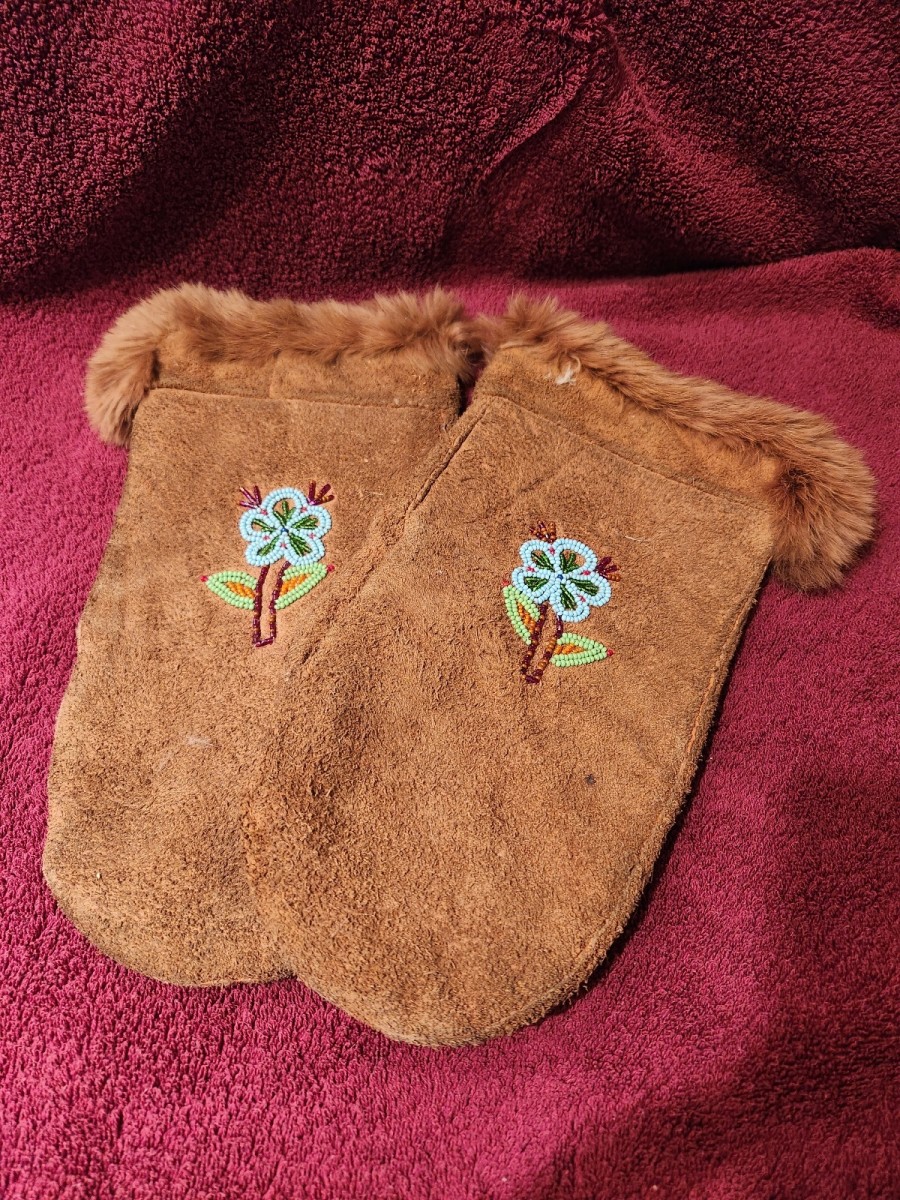Richard Arlin Walker
Special to ICT
There was something wrong, Victoria Compton thought, about the items being sent out into the world in a Store-Closing-Everything-Must-Go sale.
The ancestral objects shouted “Indigenous” in “very British” Victoria, the capital of the Canadian province of British Columbia, whose opulent Empress Hotel, Parliament building and street names are reminders of the British Empire’s expansion in the 19th century.
Among the ancestral objects up for sale: hand-woven baskets, one a century old and made using tule, feathers and porcupine quills; moccasins with an intricate, beaded flower design; fur-lined leather mittens; a carved serving spoon; and a baby carrier.

These beaded, fur-lined mittens were among several Indigenous artifacts that Victoria Compton of Washington State bought at a store going out of business in Victoria, British Columbia. She is now working to repatriate the items to their tribes of origin as early as May 2023. (Photo courtesy of Victoria Compton)
Each object was a work of art, intricately woven or carved using techniques and materials that had been employed by Indigenous people in the Northwest for millennia, Compton said.
“As a mom, the baby carrier was particularly heartbreaking to me,” said Compton, about seeing the objects in the soon-to-be-shuttered store.
“This antique object had been one family’s way of caring for their baby,” she said. “It was loved, well-used, well-crafted. Someone clearly worked hard to make this into a beautiful and durable object. It resonated with me …
“The baby carrier represented to me the unimaginable loss of generations of Native American children, and their mothers’ grief,” she said.
SUPPORT INDIGENOUS JOURNALISM. CONTRIBUTE TODAY.
Compton, an economic development agency director on San Juan Island in northwest Washington state who is not Native, said she was able to buy 12 objects. Once home, she said she realized she couldn’t keep them.
“They don’t want to live here,” she told ICT. “They want to live with the people who crafted them.”
Compton then embarked on a journey to return the objects to their Indigenous nations of origin, one of a growing number of private collectors seeking to repatriate objects of cultural, historic, or traditional importance.
Some collectors, like Compton, want to repatriate the items because they believe ancestral objects belong with the cultures from which they originated. Some want to repatriate objects that have no clear provenance — or history of ownership — leaving open the possibility they were obtained by unscrupulous or illegal means.
Under the 1990 federal law, the Native American Graves Protection and Repatriation Act, known as NAGPRA, museums, universities and government agencies that receive federal funds are required to return human remains and culturally significant and sacred objects to the tribal nations or lineal descendants.
So far, more than 83,000 human remains and 1.7 million funerary objects have been repatriated, according to a February 2022 report from the Government Accountability Office.
But for private collectors and others who have no obligation under NAGPRA to return ancestral objects to their cultures of origin, knowing how or where to start can be a puzzle.
“I understand that repatriation is a huge issue and expense for tribes and I don’t want to add to that burden if it’s not an item that should be returned,” said Mary Klinkel, a non-Native resident of Green Valley, Arizona who is seeking to repatriate a beaded leather case, believed to be from the Southwest, that she has in her possession.
“If there is a group of Indigenous experts that can look at photos and make decisions about whether items need to be repatriated or not, that could be a big help in the process.”
Seeking guidance
A good place to start is a local tribal museum, said Emily Miller, senior curator of the Tulalip Tribes’ Hibulb Cultural Center and Natural History Preserve on the Tulalip Reservation near Seattle.
The National Association of Tribal Historic Preservation Officers website, has an online directory of 74 tribal museums and cultural centers in 23 states, and museums may be able to consult by email using photographs and background information about the object, Miller said.